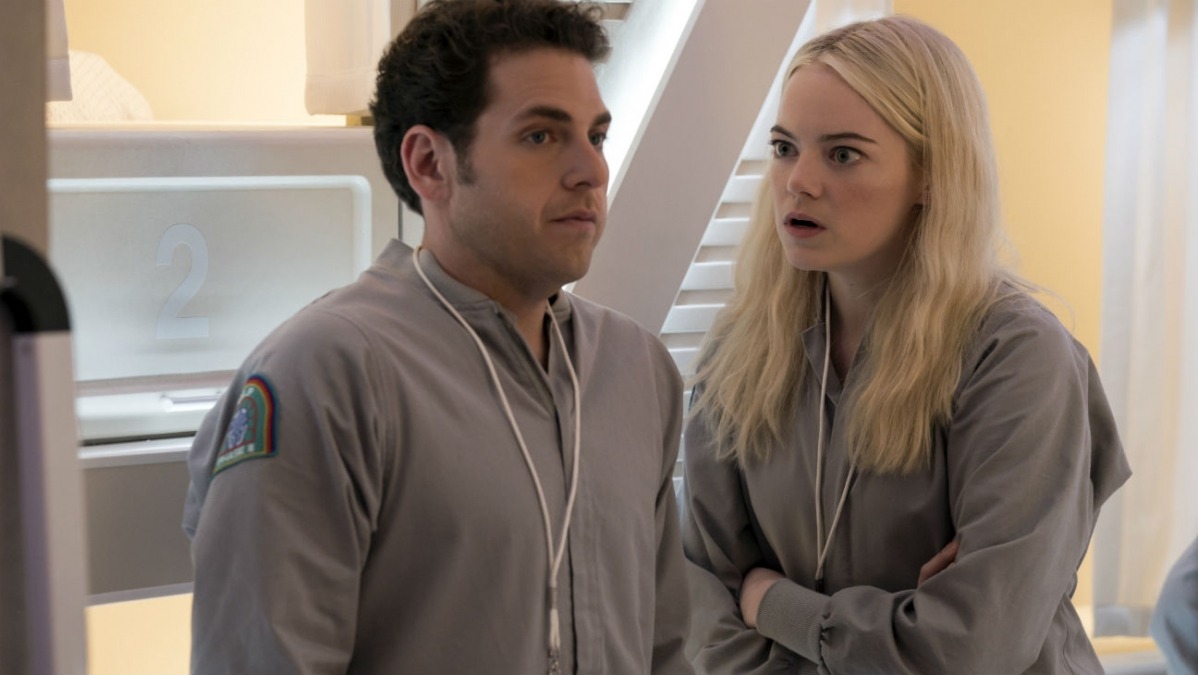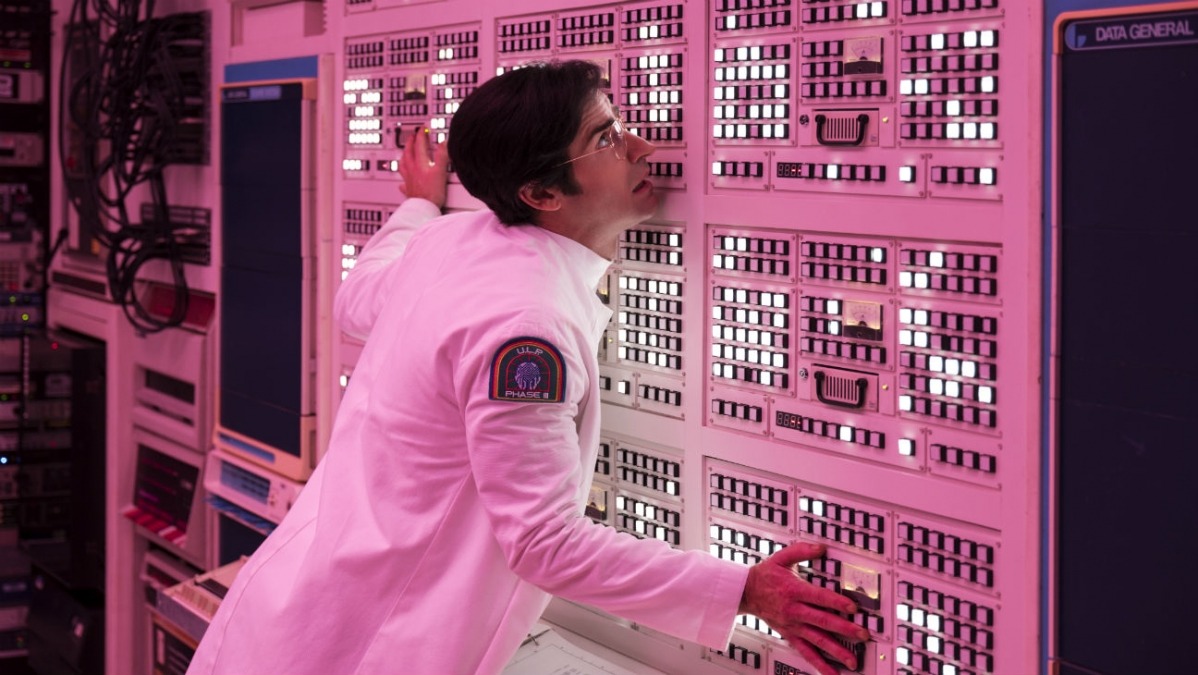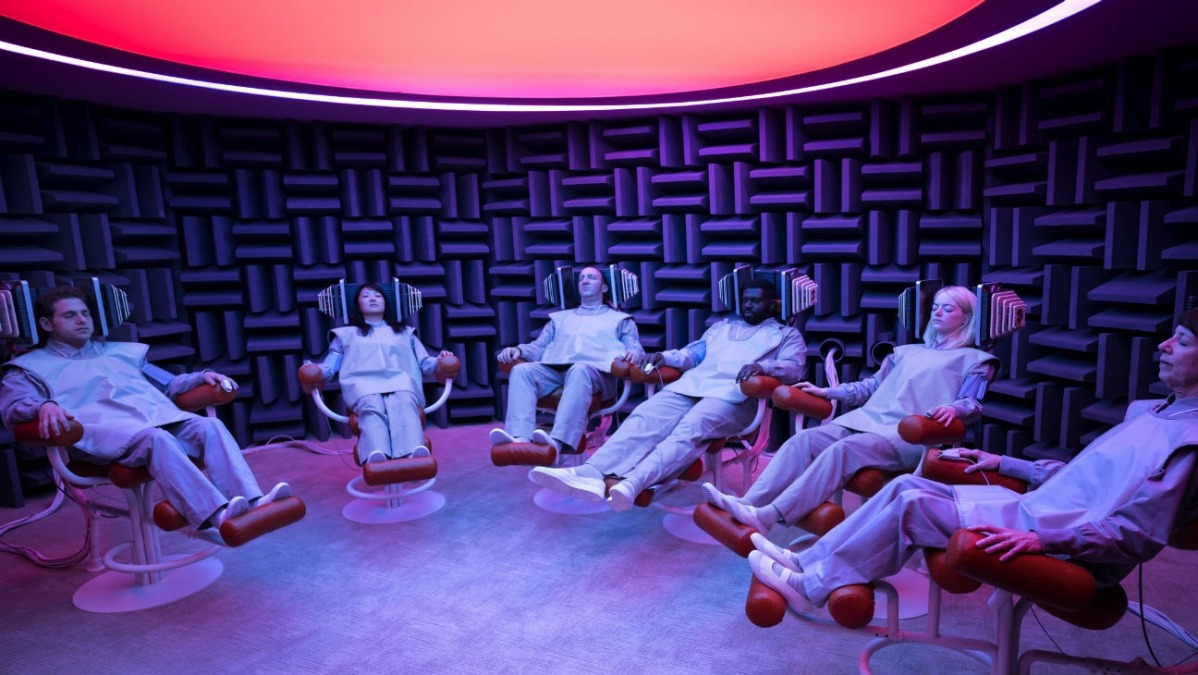Netflix’s new show Maniac asks “how do we feel better?”
Maniac writer Patrick Somerville tells us what Emma Stone and Jonah Hill’s psychotropic new Netflix show is really about…
“Pills save people’s lives,” says Patrick Somerville. “There are people who cannot live with any sense of normalcy without prescription medication.” His new ten-part Netflix series about an experimental drug trial promising miracle mental health benefits is not, he stresses, criticising the use of real-world anti-depressants.
“More than talking about pills I think the show is talking about the speed and comprehensiveness at which it’s claimed the product will help people. Three days, no side-effects, done. If the satire is aiming at anything, it’s the idea that it can be easy to heal. It’s hard to heal.”
Healing, Somerville says, is a central theme of the series. “The real question that is brought up in the beginning of Maniac is ‘how do we feel better?’ What works? What doesn’t work? How can we move forward after trauma? And I think the show posits a pretty good answer.”
Which is? “Human connection. Connecting to other people in an authentic way helps us and makes our lives better.”
The connection of three individuals—actors Emma Stone and Jonah Hill and director Cary Fukunaga—is responsible for Maniac’s existence. That trio was in place before a single script was written.
“There was a lot of enthusiasm for Cary, Jonah and Emma to work together,” says Somerville, “a lot of enthusiasm from Netflix to make a show with those three people.” They sniffed around for the right project on which to collaborate and found it in the form of 2014 Norwegian half-hour comedy Maniac, which felt ripe for an English-language remake.
The story of Espen, an unassuming patient in a residential psychiatric ward whose hallucinations cast him as the hero in a series of pop culture-inspired fantasy worlds, the Norwegian original shares scant similarities with the new Maniac.
“We wanted to use the idea of delusional worlds,” explains Somerville, but “we wanted to tell our own story.” With Hill and Stone already signed up, they “needed to reinvent the show in a way that made it work with two characters who are both experiencing delusions.”
If so much was going to be reinvented, why not just start from scratch with a brand new concept? “It’s just the way shows come together,” shrugs Somerville. “There was a very, very basic framework and sketch of a thing that everyone could do together and the show was greenlit based on that,” he tells me. “Then the hard creative work started happening afterwards”.

That work had to be sped up considerably due to the availability of Maniac’s in-demand stars. Co-ordinating the schedules of an Oscar winner, a two-time Oscar nominee and a director recently announced as having landed the biggest job in the business by replacing Danny Boyle on Bond 25 was always going to be tricky.
“There was a time when production was going to be much further in the future,” Somerville explains, “and then because Jonah and Emma’s schedules lined up, [filming] got brought up to the fall of 2017. So, the schedule for the show accelerated, things sped up and Cary and I had new conversations about the storytelling.”
The story is about Owen Milgrim (Jonah Hill) and Annie Landsberg (Stone), two disaffected loners in New York City who find their way onto an experimental drug trial that promises to leave them cleansed of pain and reborn as new, happy versions of themselves. Owen is a diagnosed paranoid schizophrenic while Annie is self-medicating to cope with her own traumas. They connect in an unexpected way at the drug trial during a psychotropic process that digs through the layers of their personality.
It is, in a word, bonkers. As the drugs take effect, Owen and Annie’s anesthetised real-world lives are taken over by colourful delusions that see Hill and Stone playing a range of characters against a range of fantasy backdrops. It’s inventive and complicated and packed with uncanny visual interest.
The world of Maniac is strange before anyone even swallows a tablet. Fukunaga and Somerville aimed to deliberately unsettle the audience by creating a setting that’s both recognisable and slightly ‘off’. “I love heightened worlds,” says Somerville. “I love taking what we accept as normal and changing it slightly and presenting it to the audience as though it is normal.”

The first episodes put viewers in the same situation as Owen, he explains. “Things out on the streets of New York look a little different inside our show, technology is a little bit different, you’re not quite sure where you are in time or what the geopolitical history of this world is.”
It’s a comic, sci-fi world, part Idiocracy, part Black Mirror, and part Philip K. Dick. A super computer has developed empathy and a taste for the poetry for William Blake, dog poo-sanitising robots roam the streets, and payments can be made by choosing to accept an “Ad Buddy” – someone who pops up to read out adverts to cover the cost of the item. “That was just sort of hilarious to me,” says Somerville, “the idea of the gig economy degrading people in an even worse way than they already do. It’s the worst example of human connection in the show.”
The dystopia isn’t all satire. “It’s a way to start talking about normalcy,” says Somerville. “In our world, we have been inundated with a massive amount of new technology that changes the way that we live and it very, very quickly settles into normal. It’s very strange that phones are what they are now, relative to when I was a kid.”
“One of the ways to get after that idea that Cary and I talked about was to have a world where our zeitgeist was present but what the technology looked like was a little bit different, just to underline and expose how strange normalcy is”.
Novelist and short story writer Somerville’s previous TV work includes HBO’s The Leftovers, on which he worked with Damon Lindelof. “I was a huge Lost fan” he says, describing Lindelof as “the bravest writer [he’s] ever met.”
Working with Lindelof has made him braver about challenging the audience with uncertainty, he agrees, though “you can’t just willy-nilly make it weird and expect the audience to stay with you.”

Always conceived as a limited series, Maniac has a complete story, Somerville promises. “ And so long as the emotional reality of a story feels true, people are willing to accept a lot around it. It might make sense but it makes sense on its own terms. We were very mindful to make the core emotional storyline of Maniac universal and accessible and present all the way through, whatever insane ideas we were pursuing along the way!”
Some of Maniac’s “insane ideas” find expression through quotes and references to other works. The sentient computer has “some Hal stuff [from 2001: A Space Odyssey] going on”. Cervantes’ Don Quixote recurs throughout as, “a story about a person who has trouble seeing reality clearly,” says Somerville. “It’s also a story about longing for heroism. In that way, that, to me, it’s very reminiscent of Owen’s path in our story.” Look out for the films playing on TVs in the back of shot too. They “play a role in the delusions that happen later in the series.”
Delusions are on Somerville’s mind on the day we speak. “We live in a time when the president of my country just Tweeted that 3,000 people did not die in Puerto Rico. Whether or not someone knows what is real, or is communicating what is real is an essential element of power.”
It’s a bleak thought, he agrees. Ultimately though, he wants Maniac to lead its audience somewhere joyful. “I’m a huge softie and I love characters coming together and feeling better and happiness. But, that has to be earned by representing real pain and real suffering. As I said,” he smiles, “healing is hard.”
All ten episodes of Maniac arrive on Netflix on Friday the 21stof September.
